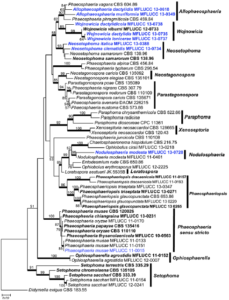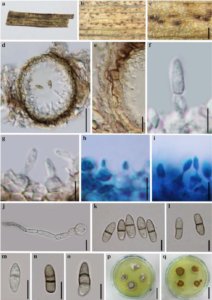Neosetophoma italica W.J. Li, Camporesi & K.D.Hyde.
Index Fungorum number: IF550920, Facesoffunginumber: FoF 00425; Fig. 2
Etymology – Named after the country where it was collected, Italy.
Holotypus – MFLU 14–0809
Saprobic on dead leaves of Iris germanica L., forming conspicuous, dark brown conidiomata. Sexual morph Undetermined. Asexual morph coelomycetous. Conidiomata 50 – 60 μm high, 40 – 75 μm diam., pycnidial, separate, dark brown, globose, subepidermal, unilocular, thinwalled, papillate. Peridium 5 – 10 μm wide, composed of 3 – 4 layers, with outer 1 – 2 layers comprising brown and inner 1 – 2 layers of pale brown to hyaline cells of textura angularis. Conidiophores reduced to conidiogenous cells. Conidiogenous cells 2 – 5 μm long × 3–6 μm wide, enteroblastic, phialidic, doliiform to ampulliform, determinate, hyaline, smooth-walled. Conidia 6 –11 × 3 – 4 μm (x̄ = 9 × 3; n = 30), subcylindrical, fusiform, or ellipsoid to fusiform, pale brown, smooth-walled, 1 – 2 – euseptate, constricted at the septa, apex and base obtuse, or sometimes with truncate base, smooth-walled.
Culture characters – Colonies on PDA, reaching 30 – 35 mm diam. after one month, slow growing, white to yellowish in the first week, with central area becoming grey after three weeks, circular, dense, aerial, reverse dark brown, filamentous. Colonies on MEA, pale grey to almost white, reverse dark brown, without any pigments produced.
Material examined – ITALY, Province of Forlì-Cesena [FC], Castrocaro Terme, on dead leaf of Iris germanica L. (Iridaceae), 20 September 2012, E. Camporesi IT–733 (MFLU 14–0809, holotype), ex-type living cultures, MFLUCC 13–0388, ICMP. GenBank ITS: KP711356; LSU: KP711361; SSU: KP711366; ibid. (KUN! HKAS 83968, isotype).
Notes – Neosetophoma, is typified by N. samararum (Desm.) Gruyter et al. and is monotypic (Gruyter et al. 2010). The species has been reported as a pathogen causing leaf spots of various hosts (Phookamsak et al. 2014). The genus is characterized by globose to irregular conidiomata, with papillate ostioles, and with yellowish conidia that are attenuate at one end (Gruyter et al. 2010). The morphological characters of N. italica are in accordance with the generic concepts of Neosetophoma, and the only difference between N. italica and N. samararum is the colour of the conidia (pale brown in N. italica, versus yellowish in N. samararum). Phylogenetic analyses based on multi-genes (Fig. 1) show that N. italica groups with two strains of N. samararum with high bootstrap support (93 %). However, N. italica is distinct from N. samararum strains, forming a distinct branch. Therefore Neosetophoma italica is introduced as novel species.

Fig. 1 Phylogram generated from Maximum likelihood (RAxML) analysis based on combined LSU, SSU and ITS sequence data of Phaeosphaeriaceae. Maximum likelihood bootstrap support values greater than 50 % are indicated above or below the nodes, and branches with Bayesian posterior probabilities greater than 0.95 are given in bold. The ex-types (reference strains) are in bold; the new isolates are in blue. The tree is rooted with Didymella exigua CBS 183.55.

Fig. 2 Neosetophoma italica (holotype) a Specimen b, c Brown conidiomata on the host surface d Vertical section of conidioma e Section of peridium f–i Conidiogenous cells and developing conidia j Germinated spore k – o Conidia p Culture on PDA. Scale bars: c = 200 μm, d = 25 μm, e = 5 μm, f – i = 5 μm, j – o = 5 μm, p = 25 mm Fungal Diversity.
